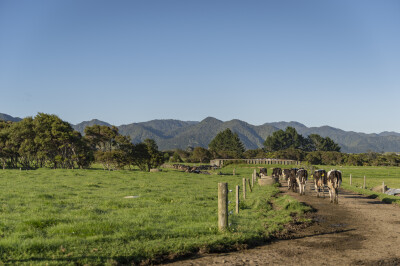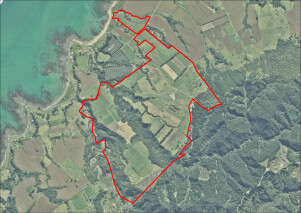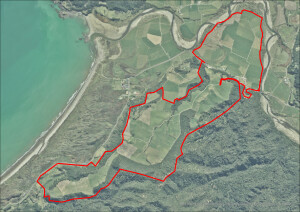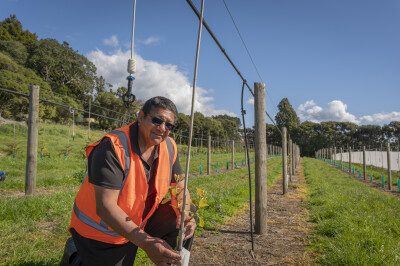Orete No. 2 and Other Blocks Incorporation, Eastern Bay of Plenty
Farming has long been a way of life for Orete - a Māori incorporation with 1,500 owners on the tip of the remote East Cape. Te Taiao is at the heart of all they do, including finding ways to keep their agricultural greenhouse gas emissions down.
About Orete
Orete No. 2 and Other Blocks Incorporation ('Orete’) is a Māori Incorporation in Waihau Bay, a remote coastal community just over 100km east of Ōpōtiki in the Bay of Plenty.
Orete was created in early 1953 through an amalgamation of land blocks within the rohe of Te Whānau a Pararaki hapū (mai i Ngutuone ki Mangatoetoe) and Te Whānau a Apanui iwi.

Main Farm, Waihau Bay (Photo credit: Dave Allen Photography)
In the early days, the whenua was farmed as a sheep and beef operation. In the mid-1970s, the Trustees at the time foresaw the need for growth and diversity and converted to dairying (‘Main Farm’).
A second dairy farm, at Whangaparaoa, was purchased in the mid-1990s (‘Cape Farm’). The original owners of this block were also beneficial owners in Orete and the farm purchase was made to keep the whenua in whānau ownership.
In addition to its farms, Orete also has forestry, road construction and engineering operations and runs the Waihau Bay Lodge.
With 1,500 owners, Orete is a complex business.
Its strategic plan has it focused on protecting and sustaining its whenua and resources to support the growth of its owners, encompassing values of Tino Rangatiratanga, Kaitiakitanga, Whakapapa, Manaakitanga and Mātauranga. Growing Orete’s business potential is key, alongside providing economic, health and social opportunities for owners and beneficiaries.
The farms

Map of Main Farm
‘Main Farm’ in Waihau Bay is 161ha effective of gently rolling land, 110km east of Ōpōtiki. Around 400 cows are milked there in a System 2 spring-calving operation with moderate supplement inputs. The farm gets 1,351mm rainfall per year and is made up of various free draining Brown and Recent soils.
‘Cape Farm’ is the other dairy block, located around 20km further east of the Main Farm on State Highway 35, inland of Cape Runaway. This farm comprises 129ha of flat to rolling country, milking just under 300 cows in a similar System 2/spring-calving operation to the Main Farm.

Map of Cape Farm
In the past, sharemilkers were engaged on both farms, but in 2018/19 Orete changed its structure to a managed farm model. Farm managers on both farms now have whakapapa links to Orete.
Environmental focus
Te Taiao/the environment has always been important to Orete. However, in late 2006, an effluent spill on the Main Farm saw the Incorporation fined for environmental damages to the Waiare Stream, which joins the Tauranga Stream before flowing into Papatea Bay. This was a shock for the owners and prompted a review of the farm’s management arrangements.
Orete worked closely with the regional council, farm advisors and farm staff to achieve compliance and develop a long-term environmental plan for their farming operations. Since then, Orete has continued to engage advisors and participate in projects with a focus on the environment.
Orete is also involved in a DairyNZ and MPI Eastern Bay of Plenty Māori Dairy Cluster initiative, designed to support and lift on-farm performance across a range of aspects, including the environment.
Getting to grips with greenhouse gas numbers
In 2019, Orete were approached to be a part of a project funded by the New Zealand Agricultural Greenhouse Gas Research Centre (NZAGRC) to support Māori-owned dairy and sheep and beef farms to identify ways that they could reduce greenhouse gas emissions. As part of that project, farm advisors and researchers worked with Orete to estimate the greenhouse gas emissions associated with the Main Farm using OverseerFM (the Cape Farm was not part of the project).
The project identified a range of different management practices and land use changes that could potentially be introduced to reduce greenhouse gas emissions on the Main Farm.
Those options were then modelled using a combination of OverseerFM and Farmax to understand the impact on both greenhouse gas emissions and profitability.
“Developing an understanding of how where our emissions come from, the options for reducing them and the impact of those options has been essential in enabling us to plan for the future,” says Dane Tamepo, Orete Business Manager and Board Member.
Note that Orete also receives greenhouse gas and other environmental data and reporting from Fonterra who they supply to. To find out more about these tools and others, see our Know Your Numbers page.
Orete's greenhouse gas numbers
Orete's greenhouse gas numbers in 2019 across its two farms were:
| Numbers | Main Farm* | Cape Farm |
| Methane (tonnes CO2-e/ha) | 6.7 | 5.1 |
| Nitrous oxide (tonnes CO2-e/ha) | 1.8 | 1.4 |
| Total biological GHGs per hectare (tonnes CO2-e/ha) | 8.5 | 6.5 |
| Total biological GHGs (tonnes CO2-e) | 1,369 | 1,062 |
| Methane* (kg) | 43,457 | 33,088 |
*The weight of methane is shown here without conversion to CO2-e because this is how it would be required to be reported in any farm-level pricing mechanism.
At the start of the project with the NZAGRC, the biological greenhouse gas emissions from the Main Farm were 8.5 tonnes of carbon dioxide equivalent per hectare (CO2e/ha). This is already slightly less than the average New Zealand dairy farm, which emits 9.6 tonnes of greenhouse gas emissions per hectare per year.
The project identified and modelled a range of different management practices and land use changes that could potentially be introduced to reduce greenhouse gas emissions on the Main Farm.
The mitigation scenarios that were modelled included:
- Reducing herd numbers, with and without improving productivity
- Reducing replacement rate
- Reducing nitrogen fertiliser use and supplementary feed
- Converting land to exotic forestry
- Converting land to kiwifruit
The results of the project's modelling and the impact on Main Farm's emissions and bottom line are shown in the table below.
| Modelled scenarios for Main Farm | Change in EBITDA | Change in GHGs | |
| 1 | Reduce cow numbers 10%; no improvement in productivity | -35% | -8% |
| 2 | Reduce cow numbers 10%; improve productivity | 33% | -6% |
| 3 | Reduce cow numbers 15%; improve productivity | 38% | -10% |
| 4 | Reduce replacement rate | 12% | -1% |
| 5 | No nitrogen fertiliser | -5% | -7% |
| 6 | No bought supplementary feed | -21% | -10% |
| 7 | No N fertiliser, no bought supplement | -16% | -17% |
| 8 | 10% of farm in pines | -7% | -34% |
| 9 | 10% of farm in pines, reducing stocking rate 10% | 11% | -39% |
| 10 | 31% of farm in pines | -55% | -106% |
| 11 | 10% of farm in gold kiwifruit | 211% | -9% |
| 12 | 13% of farm in green kiwifruit | 130% | -10% |
| 13 | 24ha pines, reduce stocking rate 16%, differential offset | -30% | -51% |
The modelling showed the extent to which each scenario reduced greenhouse gas emissions and nitrogen leaching and the impact on the farm's bottom line (EBITDA or Earnings Before Interest, Taxes, Depreciation, and Amortization).
The most promising scenario for Orete was converting 10% of the farm into gold kiwifruit (Scenario 11) - achieving a 211% change in EBITDA from the base model and a 9% reduction in emissions.
Conversion into green kiwifruit (Scenario 12) also yielded a very positive outcome for EBITDA and emissions. Other scenarios that showed promise were the reduction in stock numbers accompanied with an increase in productivity (Scenarios 2 and 3) and conversion of land to pine trees (Scenario 9).
On-farm actions

Dane Tamepo, Orete Business Manager and Board Member, inspecting the new kiwifruit vines (Photo credit: Dave Allen Photography)
While the biggest potential lay with the conversion to gold kiwifruit, the capital cost to do this was quite high. Subsequently, the Committee decided to go with Scenario 13, diversifying around 13% or 21 hectares of the farm into green kiwifruit. The first vines were planted in spring 2020.
Around the same time, a Provincial Growth Fund investment of $10.6 million for a water storage facility was approved (Raukokore River Water Ltd), aiming to boost economic growth in the region by supporting high value horticulture. Access to this water infrastructure means that Orete’s Committee can now plan further development of its kiwifruit venture.
Alongside this land use change, the farm managers at Orete are undertaking a range of other actions to reduce their environmental footprint:
- Minimising use of nitrogen fertiliser
- Improving individual animal performance
- Improving herd fertility and genetics
- Improving effluent storage and application
- Improving pasture quality
Many of these actions will help to bring their greenhouse gas emissions down further. For more, see our Current Actions page.
Orete is also participating in a study looking at the effects of banana palms on potassium levels in effluent. This will see the trees grown in a controlled environment and irrigated with dairy effluent. Planting started in 2022.
Land use change as a mitigation action
Converting dairying land into a horticultural enterprise requires a lot of planning. In addition to the financial aspects of capital, cashflow etc, physical factors such as water availability for irrigation, shelter, labour for managing and picking fruit, transport, storage, and who will market the product must all be considered. If you’re interested in reading an analysis of the challenges and opportunities to consider when seeking to diversify a farm through land use change, have a look at this report by AgFirst for MPI in 2020.
Know your numbers and have a plan
By now, all farmers and growers must have a record of their annual on-farm greenhouse gas emissions (methane and nitrous oxide). By the end of 2024, they'll also need to have a written plan in place to manage them. These requirements are part of the He Waka Eke Noa partnership and are intended to help get farmers ready for agricultural greenhouse gas emissions to be priced from 2025. To find out more on how to do this, see our Know Your Numbers page

